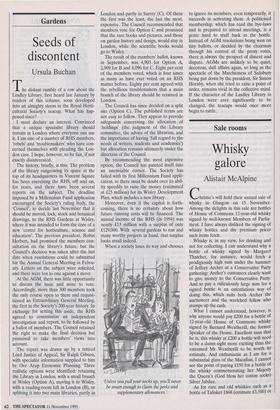Sale rooms
Whisky galore
Alistair McAlpine
Christie's will hold their annual sale of whisky in Glasgow on 15 November. Among the delights in this sale are bottles of House of Commons 12-year-old whisky signed by well-known Members of Parlia- ment. I have always disliked the signing of whisky bottles and the premium prices such items fetch.
Whisky is, in my view, for drinking and not for collecting. I can understand why a bottle of whisky signed by Margaret Thatcher, for instance, would fetch a prodigiously high sum under the hammer of Jeffrey Archer at a Conservative Party gathering: Archer's customers clearly want to give money to the Conservative Party. And to pay a ridiculously large sum for a signed bottle is an ostentatious way of doing this, which suits both Archer the auctioneer and the wretched fellow who stumps up the cash.
What I cannot understand, however, is why anyone would pay £200 for a bottle of 12-year-old House of Commons whisky signed by Bernard Weatherill, the former Speaker of the House. Excellent man that he is, this whisky at £200 a bottle will need to be a damn sight more exciting than the esteemed Mr Weatherill to be worth its estimate. And enthusiastic as I am for a substantial glass of the Macallan, I cannot see the point of paying £150 for a bottle of the whisky commemorating her Majesty the Queen's (God bless her cotton socks) Silver Jubilee.
As for rare and old whiskies such as a bottle of Talisker 1868 (estimate £3,500) or a bottle of the Glenlivet 1874 (estimate £3,000), I regard buying such things as a terrible folly. Save yourselves a trip to Glasgow and visit instead any respectable wine merchant and acquire a bottle of the Macallan Ten Year Old. But be sure that it is the ten-year-old with a red stripe bearing the words 'full proof' across its label.
The obsession with signing whatever comes to hand is, however, no new enthusi- asm. Stalin was quick to realise the value of getting those whom he came across to sign documents — whether they were treaties or menus. At a dinner given during the Potsdam Conference, Stalin upset Churchill by passing round his menu for all those present to sign. This caused consider- able confusion, for soon 28 menus were going backwards and forwards .among the guests who were desperately short of foun- tain pens. A programme belonging to Mar- shal Zhukov, giving details of the evening's seating and music and duly signed by 13 of those present, including Stalin and Churchill, is for sale at Christie's in South Kensington on 17 November and is likely to fetch £15,000. In the same sale is Sir Winston Churchill's personal sten gun, a deactivated sten MKIII submachine-gun no. A42485, mounted on a wooden display stand; it is expected to fetch £10,000.
Churchill, it seems, kept quite a collec- tion of weapons at Chartwell, his country home. These were no mere souvenirs for Churchill practised with them regularly, and fully intended to use them should he come across any Germans. Sir John Colville, Winston Churchill's private secre- tary, made the following entry in his diary in August 1940 after visiting a shooting range where Churchill, smoking his cigar, practised with a revolver: 'despite his age and lack of practice, he acquitted himself well; he always seemed to visualise the pos- sibility of having to defend himself against German troops'. Objects that belonged to famous people have always sold well in recent years, and I have no doubt that Oscar Wilde's ink stand in the same sale (estimate £2,500) will fetch considerably more than that sum. On 21 November, Christie's are selling the second part of goods and chattels that belonged to the late Rudolf Nureyev. I have come to the conclusion that I would look really rather grand in his red '19th- century Turkish robe, densely embroidered in couched gilt arabesques' (estimate £1,000). Somewhat reluctantly, however, I have had to abandon the idea for we were built rather differently.
It was something of a relief that I have come across a painting of two fat men, `les Musicas' by Fernando Botero, in Christie's 20 November sale of important Latin American paintings, drawings and sculp- ture. To find that Botero's work (which depicts vastly fat men and women) is popu- lar in an age of an almost universal 'desire to be anorexic is indeed reassuring. This particular pair of well-built musicians is likely to fetch $500,000.
In their sale of 'Fine American Indian Art' on 30 November, Sotheby's have a prehistoric Eskimo head carved in ivory from c. 200 BC to 100 AD. Two and three quarter inches high, this head is a sculpture of immense beauty. By comparison, the work of Modigliani and Brancusi carved almost 2,000 years later seems quite pedes- trian. The estimate for this masterpiece is £50,000, a modest price when you consider the high figures that 20th-century sculpture fetches.
On 22 November, Sotheby's have a sale of Modern British and Irish Paintings, Drawings and Sculpture. This market has never reached the heights that the French Impressionists and Modern Art scaled, only to crash down again a few years ago. I was particularly interested in a painting by Mark Gertler, 'Nude with a Mandolin' (esti- mated to reach £25,000). I bought a very similar painting by this artist in Sotheby's during the 1960s for £250 — and I have to admit that I was delighted to double my money when I sold it a year later. I write about this act of folly simply to make the point that while the art market can go up it also can come down. The collectors who make the biggest profits are the ones who hang on to the goods they buy the longest.



















































































 Previous page
Previous page